With advancements in GenAI and new promises of transformation, effectively integrating educational technology in classrooms and ensuring equitable learning experiences for all students are more crucial than ever. The National Education Technology Plan outlines ambitious goals for digital equity. Achieving them requires actionable insights and informed strategies. Enter the Speak Up Leader Survey, a powerful tool that connects the dots by providing a digital equity readiness report to inform their next steps in closing the three digital divides.
Addressing Digital Inequity in Schools
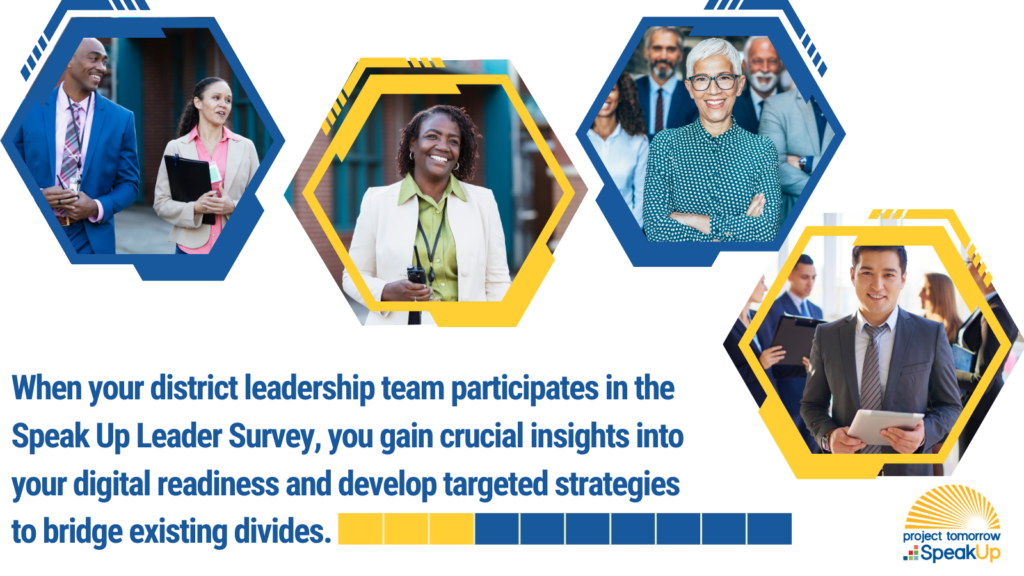
If you are a regular consumer of TechNotes, you will recall last month’s post “The 2024 National Educational Technology Plan (NETP): Closing The Digital Divide.” TCEA’s Government Relations Director Matt Russell outlined all the ways that TCEA members can benefit from the organization’s offerings aligned to the plan’s call to action.
As a quick refresher, the recently released National Educational Technology Plan (NETP) puts a laser focus on equity concerns in education. It emphasizes how technology could be better used in the classroom to support learning for all students through the lens of three digital divides: access, design, and usage. As a member of the NETP development team, Project Tomorrow is very proud of this focus and the plan’s recommendations for addressing digital inequity. But you may be asking yourself:
- Are we ready to address the equity challenges?
- Are we prepared to implement the recommendations in the NETP?
- Where do we need to begin?
Get Your Readiness Report Card
Project Tomorrow, in partnership with TCEA, can help you answer those questions with our new Speak Up Leader Survey. Encourage your district administrators and school building leaders to complete the 15-minute survey. In turn, we will send you a report card on your overall readiness to tackle digital equity in your district. Getting started is as easy as registering your district! Project Tomorrow will send you a customized link for distribution. We’ve even put together this promotional toolkit for TCEA members with messaging to take to your cabinet for approval requests and to help promote participation once approved.
You are invited to preview the survey. Note that Speak Up participation is free to all schools and districts. All data collected is confidential and no single individual can be identified from any submitted entry. Don’t delay. The survey closes on June 21 for TCEA members.
Speak Up Leader Survey Details at a Glance:
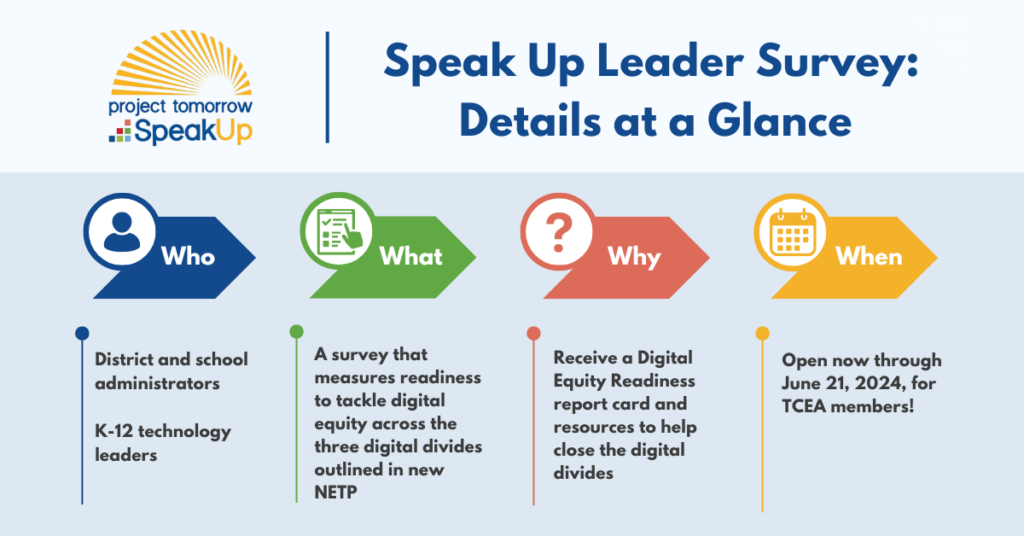
What: Measures readiness to tackle digital equity across the three digital divides outlined in new NETP
Who: District and school administrators, K-12 technology leaders
Why: Receive a Digital Equity Readiness report card and resources to help close the digital divides
When: Open now through June 21, 2024, for TCEA members!
Thank you, TCEA, for your partnership and for supporting Speak Up.





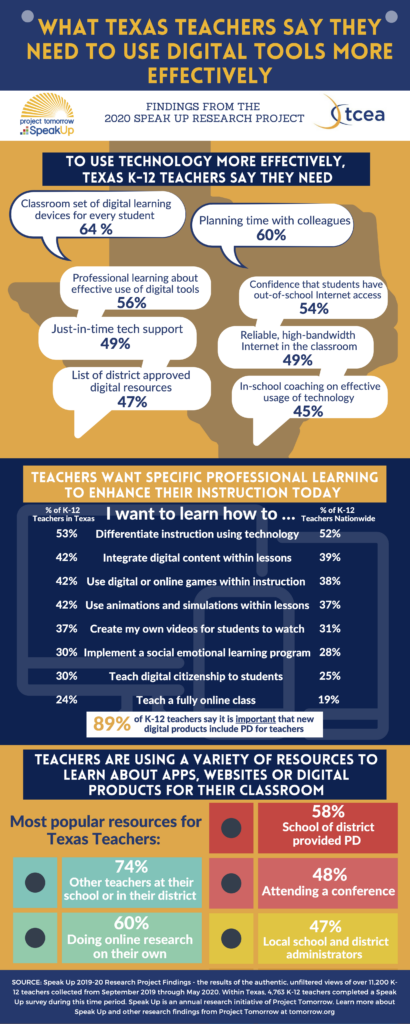
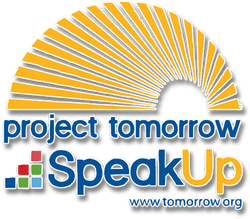
 something because of their interests. This helps me see how students are using technology when they are looking for specific information or want to learn a skill. Only 9% of both middle and high school students post a question on a discussion board or a forum. Do we need to be more intentional in using this type of application? Do they just not know how, or have they found better ways to seek answers to their questions?
something because of their interests. This helps me see how students are using technology when they are looking for specific information or want to learn a skill. Only 9% of both middle and high school students post a question on a discussion board or a forum. Do we need to be more intentional in using this type of application? Do they just not know how, or have they found better ways to seek answers to their questions?  I also discovered that 43% of my teachers are facilitating student collaboration projects using online tools. This is such a great skill. How can I leverage these teachers to help other teachers do this as well? Also, I’m pleasantly surprised that 44% of my teachers are using an online curriculum. However, I want to know more. What is the frequency? Are they occasionally doing this or is this something they use every day? I also want to know what they are using. Are they using the district’s Learning Management System, or is it an online textbook?
I also discovered that 43% of my teachers are facilitating student collaboration projects using online tools. This is such a great skill. How can I leverage these teachers to help other teachers do this as well? Also, I’m pleasantly surprised that 44% of my teachers are using an online curriculum. However, I want to know more. What is the frequency? Are they occasionally doing this or is this something they use every day? I also want to know what they are using. Are they using the district’s Learning Management System, or is it an online textbook?  integrate digital content, tools, and resources into their daily instruction. 51% said they wished they had a classroom set of digital devices. 49% said they needed to know that their students had adequate broadband access outside of school and 46% indicated they were concerned that they didn’t have consistent, reliable internet access within school. Maybe I need to have my staff do some focus groups related to internet access and speed. Looking at my network resources, they should have adequate bandwidth, but maybe something is happening on campus that I am not aware of. While my team is on campus, I probably should also have them ask teachers about the availability of technical support since 47% of the teachers indicated it was lacking. And lastly, my teachers still need time to plan with their colleagues (60%) and additional professional development (50%). I need more staff to be able to meet this need!
integrate digital content, tools, and resources into their daily instruction. 51% said they wished they had a classroom set of digital devices. 49% said they needed to know that their students had adequate broadband access outside of school and 46% indicated they were concerned that they didn’t have consistent, reliable internet access within school. Maybe I need to have my staff do some focus groups related to internet access and speed. Looking at my network resources, they should have adequate bandwidth, but maybe something is happening on campus that I am not aware of. While my team is on campus, I probably should also have them ask teachers about the availability of technical support since 47% of the teachers indicated it was lacking. And lastly, my teachers still need time to plan with their colleagues (60%) and additional professional development (50%). I need more staff to be able to meet this need! 


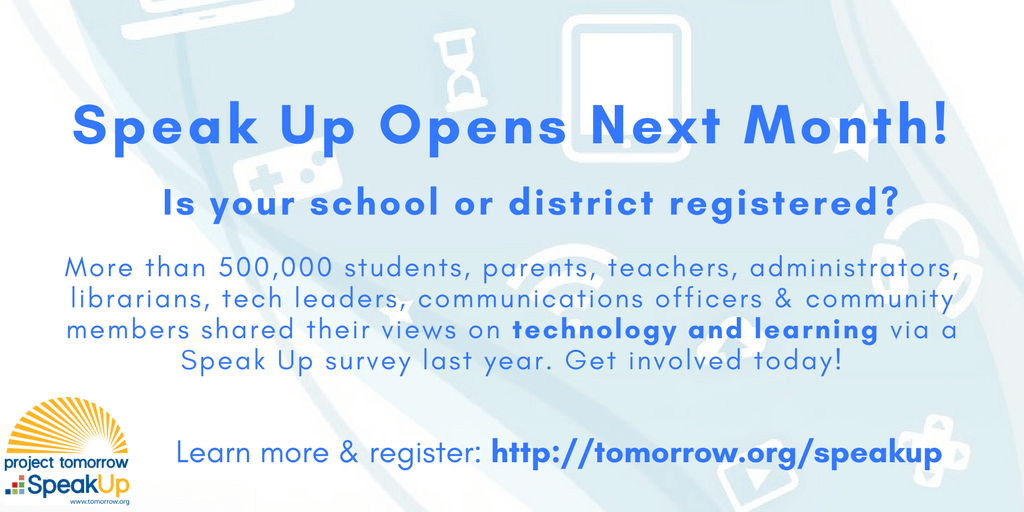
 prepared to be tomorrow’s innovators, leaders, and engaged citizens of the world.” The
prepared to be tomorrow’s innovators, leaders, and engaged citizens of the world.” The  You have complete flexibility with the implementation of the survey. If this is your first time, you could start small by targeting one school or one grade level. You could decide to only survey students and staff this year and add parents and community members the following year. Just remember, the more data collected, the more information you will have for your strategic planning. This brings us to the best part. After the data is collected, Project Tomorrow analyzes it and provides you with your own data in an extremely easy format to read and manipulate. They even have a PowerPoint template that you can use to easily import your district’s data.
You have complete flexibility with the implementation of the survey. If this is your first time, you could start small by targeting one school or one grade level. You could decide to only survey students and staff this year and add parents and community members the following year. Just remember, the more data collected, the more information you will have for your strategic planning. This brings us to the best part. After the data is collected, Project Tomorrow analyzes it and provides you with your own data in an extremely easy format to read and manipulate. They even have a PowerPoint template that you can use to easily import your district’s data. 
